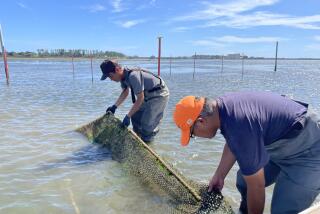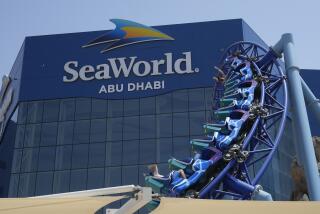U.S. Biologists Use Red Sea to Turn Eritrean Desert Into Shrimp Farm
MASSAWA, Eritrea — The Americans in shorts and baseball caps dip their hands in chlorine before plunging them into the waist-high circular concrete tanks filled with seawater on the deserted stretch of Red Sea beach.
The shrimp inside are their prime investment in a sea farming project that stands to make a lot of money as well for this tiny, impoverished nation in the Horn of Africa.
Less than a decade after Eritrean rebels defeated Ethiopian tanks on the hot, humid stretch of desert beach in their 30-year fight for independence, the government invited the team from the University of Arizona to put years of environmental research to work by using the Red Sea to irrigate farms for shrimp, fish and sea crops.
“We’re reversing the flow of water, which runs from the mountains and washes the soil into the sea, by recapturing nutrients and putting them back into the land,” said Ned Daugherty, a university researcher and the environmental architect at Seaphire International’s first African sea farm.
In 1999, Daugherty and his associates set up Seawater Farms Eritrea, a joint venture between the Phoenix, Arizona-based Seaphire and the Eritrean government. They began by laying miles of pipe across the beach to pump seawater onto 1,482 acres of desert.
The pipe that runs past a burned-out T-55 tank delivers seawater to 230 brick-and-concrete tanks lined up in neat rows. Each tank is home to 200,000 post-larvae shrimp that were flown to Eritrea from a Seaphire hatchery in Mexico. The Eritrean farm is building its own hatchery stocked with selected shrimp that take six to eight months to mature.
After passing through the shrimp tanks, the seawater then flows into the farm’s three artificial salt lakes where tilapia, a tropical fish, are bred for export. Tilapia fish meal is also used to make shrimp feed, and the fish’s skin can be turned into attractive leather.
The water also irrigates crops like succulent salicornia, known as sea asparagus. The crunchy, thin green plant can be eaten as a vegetable, and protein-rich oil is extracted from its seeds. Dried, crushed stems are turned into fuel briquettes or particleboard.
The seawater is then carried to 200,000 mangrove trees and other sea-growing crops, some of which are still being raised experimentally. From there, the pipe dumps the water, by now rich with shrimp excrement and other waste, into a artificial wetland that has already attracted more than 154 species of birds--123 of them on the endangered list--before it returns, filtered, to the sea.
“We believe firmly that projects like this can bring wealth and peace if done in a good fashion. We want to enhance the environment, generate wealth and bring beauty and industry to Eritrean people,” Daugherty said.
The farm, which he calls “the adventure of a lifetime,” is the brainchild of Carl Hodges, a 63-year-old Arizona native. Hodges began academic life as an atomic physicist, then devoted more than 30 years of research to studying alternative sources of power and innovative use of waste space to grow food. This--and an Eritrean businesswoman who happened to attend one of his University of Arizona lectures in Tucson--brought him to the Red Sea.
Four days after he arrived in Eritrea in 1998, he sealed a $10-million deal with the government of President Isais Afwerki to launch the sea farm in which Seaphire and the Ministry of Fisheries each have a 50% stake.
The government plans to sell its share to the private sector, and the International Finance Corp., the private lending arm of the World Bank, has already visited the farm and opened negotiations to buy a portion of shares and invest in its expansion, which will include a resort hotel and a theme park.
The first harvest is expected in April or May, and Hodges said the 40 million shrimp could fetch $12.5 million in Europe and the United States.
“It is absolutely imperative that we make a lot of money, because the only way we are going to solve the planetary scale problems that we have is if business starts off and we demonstrate that people--farmers and investors--can make money,” Hodges said.
The night Hodges landed in Asmara carrying baby shrimp and salicornia seeds, Ethiopian fighter jets bombed the airport in the first weeks of what turned out to be a two-year border war between the two countries. Many of the Americans living in Eritrea chose to leave then, but Hodges stayed.
“Somebody had to feed the shrimps,” he said.
His colleagues eventually returned, and a Dec. 12 peace treaty appears to have ended the war.
The farm produces its own shrimp feed, which Seaphire says amounts to 60% of the total cost of raising shrimp. The mixture of seaweed, fish meal and imported vitamins makes the shrimp grow 1 1/2 times faster than normal.
Hodges said a major international cosmetics company was negotiating with Seaphire to use salicornia oil for a skin-care cream. The dried mangrove poles are used in construction and furniture.
“Until now, the conventional wisdom had it that environment and economic profit are in competition with each other, but that’s not true at all,” Daugherty said.
Population growth, rising temperatures, falling water tables, reduction in cropland per person, collapsing fisheries, shrinking forests and the loss of plant and animal species have all affected the planet as a result of 50 years of intensified industrialization, environmentalists say.
“Seawater Farms Eritrea addresses the first of the seven [trends] indirectly and the others directly,” Hodges said. “The way to address the population issue in Eritrea, which has a very high birth rate, is through generating wealth through a good environmental plan.”
In Massawa, one of Eritrea’s two major Red Sea ports, the government has completed an international airport, and next to it an ice factory that will facilitate the rapid export of shrimp.
“This is a dream for us. We can visit the farm any time, and there are job opportunities,” said Michael Tesfe, 28, a fisherman and diver in Massawa who also works part time on the sea farm.
Eritreans studying marine biology and agriculture obtain practical experience at the sea farm, and 40 high school students work at the farm on their holiday break together with 150 soldiers who are digging pipe channels.
“We’ve earned their respect continually,” Hodges said of government response. “We started very small, and they’ve been watching us grow. It’s been a match made in heaven.”
*
https://www.seawaterfarms.com
More to Read
Sign up for Essential California
The most important California stories and recommendations in your inbox every morning.
You may occasionally receive promotional content from the Los Angeles Times.










